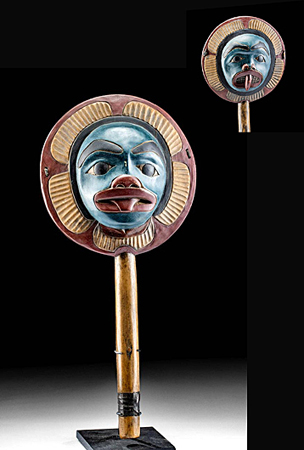
Owner: HWMC
Catalog#: 2NA-IDST-28
Provenance: Brad and Mary Watts of Phoenix, Arizona
Rattles
Kwakwaka'wakw Ceremonial 'Two-Faced' Rattle
British Columbia
Northwest Coast / Kwakwa̱ka̱ʼwakw, (also called Kwakiutl)
Wood, paint
ca. 1960s
Length: 16.5 in; Width: 7.125 in
Idiophones – Struck – Indirectly Struck – Rattles
This vintage Kwakwaka’wakw (Kwakiutl) polychromed wooden two-faced rattle displays the characteristic ovoid (egg-shaped) eyes and strongly outlined eyebrows of the Northwest Coast style. Rattles were very important pieces of shamanic equipment/tools, providing rhythm for songs, dances, and chants. For the shaman they also serviced to attract spirits to the séances. This round rattle depicts an anthropomorphic face on both sides with a red tipped nose, red lips, and an extended tongue on one side, showing teeth. The complexion is painted blue and is surrounded by a radiating border featuring five golden, ribbed/rayed, scalloped forms against a red background. The wooden handle is carved to comprise a tubular form with a leather wrap holding the two halves together and to secure the faces of the actual rattle above.
The Kwakwaka’wakw (Kwakiutl) are an indigenous people who live in British Columbia on northern Vancouver Island and the adjoining mainland. Historically, the Kwakwaka’wakw (Kwakiutl) believe that their ancestors came in the forms of animals by way of land, sea or underground. When one of these ancestral animals arrived at the given spot, it would discard its animal appearance and become human. Some animals that figure in these origin myths include the Thunderbird, his brother ‘Kolus,’ the seagull, orca, grizzly bear, or chief ghost. Nevertheless, some of the other ancestors are believed to have human origins and are said to have come from distant places. For the Kwakwaka’wakw (Kwakiutl) wealth and status were not determined by how much you had, but by how much you had to give away (Potlatches).
Reference: Minneapolis Institute of Art (artsmia.org)
